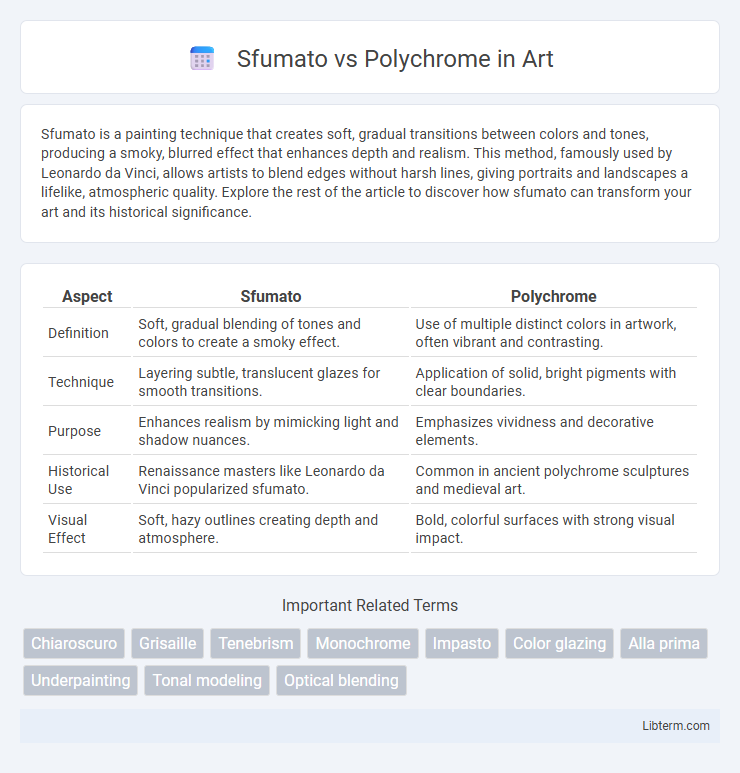Sfumato is a painting technique that creates soft, gradual transitions between colors and tones, producing a smoky, blurred effect that enhances depth and realism. This method, famously used by Leonardo da Vinci, allows artists to blend edges without harsh lines, giving portraits and landscapes a lifelike, atmospheric quality. Explore the rest of the article to discover how sfumato can transform your art and its historical significance.
Table of Comparison
| Aspect | Sfumato | Polychrome |
|---|---|---|
| Definition | Soft, gradual blending of tones and colors to create a smoky effect. | Use of multiple distinct colors in artwork, often vibrant and contrasting. |
| Technique | Layering subtle, translucent glazes for smooth transitions. | Application of solid, bright pigments with clear boundaries. |
| Purpose | Enhances realism by mimicking light and shadow nuances. | Emphasizes vividness and decorative elements. |
| Historical Use | Renaissance masters like Leonardo da Vinci popularized sfumato. | Common in ancient polychrome sculptures and medieval art. |
| Visual Effect | Soft, hazy outlines creating depth and atmosphere. | Bold, colorful surfaces with strong visual impact. |
Introduction to Sfumato and Polychrome
Sfumato is a painting technique characterized by soft, gradual transitions between colors and tones, creating a smoky, atmospheric effect that enhances realism and depth. Polychrome refers to the use of multiple, vibrant colors applied to sculptures or architectural elements, adding vividness and visual interest. Both techniques serve distinct artistic purposes: Sfumato emphasizes subtle shading and blending, while polychrome highlights color diversity and complexity.
Historical Origins of Sfumato
Sfumato originated during the Italian Renaissance, pioneered by Leonardo da Vinci as a technique to create soft transitions between colors and tones, mimicking natural light and shadow. Unlike polychrome, which involves the application of multiple vivid colors on sculptures or architectural elements, sfumato emphasizes subtle gradations without harsh lines to achieve a smoky, atmospheric effect. This method revolutionized portraiture and landscape painting by enhancing realism and depth through delicate blending.
Evolution of Polychrome Techniques
Polychrome techniques evolved significantly during the Renaissance, incorporating multiple layers of pigment to create vibrant, lifelike colors in sculpture and painting. Unlike sfumato, which relies on subtle gradations of tone to produce soft transitions and realistic shadows, polychromy emphasizes the use of diverse colors to enhance detail and realism, especially in wooden sculptures and architectural elements. The continuous experimentation with binders, pigments, and surface treatments in polychrome art allowed for greater durability and visual depth, shaping the aesthetic practices across Europe.
Key Differences Between Sfumato and Polychrome
Sfumato is a painting technique characterized by soft, gradual transitions between colors and tones to create a smoky, blurred effect, primarily used in Renaissance portraiture to enhance realism. Polychrome refers to the use of multiple distinct colors, often applied in bright, contrasting layers, commonly found in decorative arts and sculptures for vibrant visual impact. The key difference lies in sfumato's subtle blending to mimic natural light and shadow versus polychrome's emphasis on vivid, separate color application to highlight form and detail.
Famous Artists Who Used Sfumato
Leonardo da Vinci is the most renowned artist associated with sfumato, using it to create lifelike softness and depth in works like the Mona Lisa and The Virgin of the Rocks. Other notable artists who employed sfumato include Correggio, whose delicate transitions in light and shadow enhanced the sensuality of his figures, and Raphael, who incorporated subtle gradations to achieve naturalism in his portraits. Unlike polychrome techniques that emphasize vibrant, multi-colored palettes in sculpture or painting, sfumato relies on blending tones and hues to eliminate harsh outlines, resulting in a smoky, atmospheric effect.
Notable Works Featuring Polychrome
Notable works featuring polychrome include Stradivari's violins, renowned for their rich, multi-layered lacquer finishes that enhance both aesthetic appeal and acoustic performance. Polychrome techniques are evident in medieval religious sculptures, where vibrant, multi-hued paint preserved intricate details and lifelike textures. This method contrasts with sfumato, which emphasizes subtle gradations and blurred edges rather than bold, varied color application.
Technical Processes: Sfumato Explained
Sfumato is a painting technique characterized by delicate, gradual transitions between colors and tones, creating a smoky, blurred effect without harsh lines. Artists achieve sfumato through meticulous layering of translucent glazes and fine brushwork, often using soft brushes to blend pigments seamlessly. This method contrasts with polychrome techniques, which emphasize distinct, vibrant color applications rather than subtle tonal modulation.
Application Methods in Polychrome Art
Polychrome art employs multiple application methods, including layering pigments and binders to achieve vibrant, multi-colored surfaces on sculptures and architectural elements. Techniques such as fresco painting and tempera application allow artists to build rich, opaque coatings while preserving fine details. In contrast to sfumato's subtle blending, polychrome emphasizes distinct, vivid hues applied in successive layers to enhance texture and visual depth.
Visual Effects: Comparing Sfumato and Polychrome
Sfumato creates a soft, gradual transition between colors and tones, producing a smoky, blurred effect that enhances depth and realism in paintings. Polychrome employs multiple vivid colors applied in distinct, often contrasting areas, resulting in visually striking and decorative surfaces that emphasize form and texture. The subtlety of sfumato offers smooth visual gradations, whereas polychrome emphasizes bold color contrasts for dynamic visual impact.
Influence and Legacy in Contemporary Art
Sfumato, characterized by its delicate blending of tones and soft transitions, profoundly influences contemporary portraiture and digital art by enhancing realism and emotional depth. Polychrome, known for its vibrant, multicolored approach, inspires modern installations and street art that emphasize bold visual impact and cultural narratives. Together, these techniques shape current artistic practices by merging traditional methods with innovative expressions in color theory and texture.
Sfumato Infographic

 libterm.com
libterm.com